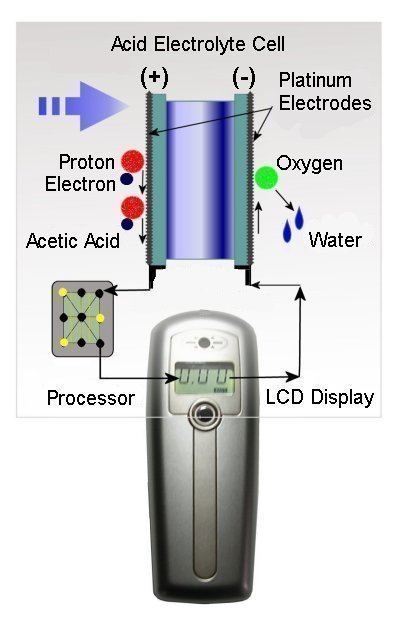Breathalyzers
A breathalyzer, also known as a breath analyzer, is a device used to estimate the blood alcohol content of a person by using a sample of air from a person's breath.
Applications
The breathalyzer is typically used as a handheld device by law enforcement agents as a way to prevent a person from operating any moving vehicle unsafely if suspected of operating the vehicle unsafely. These "vehicles" include but are not limited to: cars, airplanes, trains, buses, motorized scooters, tractors, bicycles, or even motorized wheelchairs.
The breathalyzer is often used as evidence in cases when the driver's blood alcohol concentration (BAC) is 0.08% or above in the United States, often resulting in a DUI or DWI.
The breathalyzer has also been seen in similar applications where people who are/were considered to be unsafe drivers would have a breathalyzer attached to their car. This device, when used on a car, is called an "ignition interlock". Before the driver starts the car, the driver has to blow into the breathalyzer. The breathalyzer takes the information and, if the person is below 0.04% BAC (typically), the ignition will allow the car to start.
3 Types of Breathalyzers
1) Semiconductor oxide-based testers (aka Electronic Alcohol Breath Analyzers):
This is the newest kind of breathalyzer. An ethanol-specific sensor is used to measure the person's BAC.

Each molecule of ethyl alcohol is stripped of two protons and electrons when it encounters the acid electrolyte cell. The resultant of the ethyl alcohol is acetic acid. The protons move to combine with the oxygen to create water. The electrons move through the processor, which converts the current into a quantifiable value in the LCD display.
2) Spectrophotometer testers (aka intoxilyzer):
This is the most common type of breathalyzer used by police officers while at the police station and has also proven to be most accurate.

This works in the following way:
A-A lamp generates a mutiple-wavelength infrared beam
B and C-The inlet and outlet of the person's breath
D-The chamber the infrared beam passes though
E-The inlet and outlet of the IR beam
F-The filter wheel which only allows specific wavelengths associated with ethanol
G-The photocell which converts the IR light into an electric pulse
H-The microprocessor which takes the data, calculates the BAC, and sends it to the output
3) Fuel cell testers:
This is the most common type of breathalyzer used by police officers when outside of the police station.
When a person blows into the breathalyzer, the sample of air encounters a chamber which traps the air. Any alcohol from this sample will cause a chemical reaction with two glass vials containing potassium dichromate and sulfuric acid. When the ethyl alcohol from a person's breath reacts with the two compounds, the resulting compounds are chromium sulfate, potassium sulfate, acetic acid and water. The color of the mixture will change from reddish-orange to green. The degree of hue change in the potassium dichromate is directly proportional to the amount of alcohol in the sample. An electrical current is generated by this reaction and is then converted into a output which displays the reading Webmail.

Common Misconceptions
Breathalyzers do not directly measure the BAC of a person. Instead they estimate the BAC using a 2100:1 ratio of breath alcohol to blood alcohol.
Breathalyzers are not accurate until a minimum of 15-20 minutes after food/alcohol has been ingested. This is the minimum amount of time that it normally takes for the alcohol to be completely ingested or absorbed from of a person's tongue/mouth. Again, the alcohol is measured from a person's breath and not from their saliva.
The pattern of a person's breathing can affect the BAC estimate by the breathalyzer. The alveolar sacs in the lungs tend to contain a larger alcohol content than the person's actual BAC (for which the breathalyzers are calibrated). This means that the BAC estimate by the breathalyzer can be 50% higher than the person's actual BAC if they blow very hard into the breathalyzer.
There is no known way to trick a breathalyzer, although various types have been known to have inaccuracies of as much as .05%.
Comments (0)
You don't have permission to comment on this page.